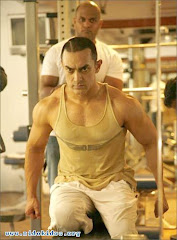The Gluteus is comprise of three smaller muscles, the Gluteus Maximus, the Gluteus Medius and the Gluteus Minimus. The gluteus is our rear end, and is the biggest muscle group on the body.
The gluteus is mainly responsible for allowing your legs to rotate at the hip, turing the thighbones outward. This is called an "external rotator." Because there are more muscles that act as "inward rotators" - muscles that pull the thighs inward - than external rotators, the lack of proper exercise will cause the outward rotators to weaken, in turn causing the thighs to point inwards. This results in several problems, including pigeon-toes, and high arches in feet. It can also cause undo strain on the knees, and tightening of the hamstrings.
Sunday, April 26, 2009
Hamstrings Muscle
Hamstrings consist of three major muscles, the Biceps Femoris, Semitendinosus and the Semimembranosus, and are located in the rear thigh.
 Hamstrings control the bending of the knees and have much to do with correct posture. With weak hamstrings, one may have a tenancy to lock one's knees, bringing the body over it's center line, and causing more extreme curves in the spine. Hamstrings also help us keep balanced as we walk.
Hamstrings control the bending of the knees and have much to do with correct posture. With weak hamstrings, one may have a tenancy to lock one's knees, bringing the body over it's center line, and causing more extreme curves in the spine. Hamstrings also help us keep balanced as we walk.
 Hamstrings control the bending of the knees and have much to do with correct posture. With weak hamstrings, one may have a tenancy to lock one's knees, bringing the body over it's center line, and causing more extreme curves in the spine. Hamstrings also help us keep balanced as we walk.
Hamstrings control the bending of the knees and have much to do with correct posture. With weak hamstrings, one may have a tenancy to lock one's knees, bringing the body over it's center line, and causing more extreme curves in the spine. Hamstrings also help us keep balanced as we walk.
Abdomen Muscle
Back Muscle
The Upper Back consists of several different muscle groups, including the trapezius and rhomboids. The trapezius (known as "traps") is a large muscle group extending from the upper back down the middle of the back. Rhomboids is a large muscle group in the middle of the back. The Latissimus Dorsi (known also as "lats") stretch from the upper arm ot the lower back.

 The upper back muscles, including the rhomboids and trapezius, hand much of the burden of lifting, and do much of the work rotating the scapula (shoulder blade). These muscles are normally one of the strongest muscles on the body because they are required for so much of our daily work. However, since rhomboids retract the shoulders, and elevate the shoulder blades, weak rhomboids can result in a decline of proper posture. Weakness in any of the major back muscles can result in bad posture.
The upper back muscles, including the rhomboids and trapezius, hand much of the burden of lifting, and do much of the work rotating the scapula (shoulder blade). These muscles are normally one of the strongest muscles on the body because they are required for so much of our daily work. However, since rhomboids retract the shoulders, and elevate the shoulder blades, weak rhomboids can result in a decline of proper posture. Weakness in any of the major back muscles can result in bad posture.

 The upper back muscles, including the rhomboids and trapezius, hand much of the burden of lifting, and do much of the work rotating the scapula (shoulder blade). These muscles are normally one of the strongest muscles on the body because they are required for so much of our daily work. However, since rhomboids retract the shoulders, and elevate the shoulder blades, weak rhomboids can result in a decline of proper posture. Weakness in any of the major back muscles can result in bad posture.
The upper back muscles, including the rhomboids and trapezius, hand much of the burden of lifting, and do much of the work rotating the scapula (shoulder blade). These muscles are normally one of the strongest muscles on the body because they are required for so much of our daily work. However, since rhomboids retract the shoulders, and elevate the shoulder blades, weak rhomboids can result in a decline of proper posture. Weakness in any of the major back muscles can result in bad posture.Calves Muscle
Chest Muscle
The Chest consists of four major muscle groups: the Pectoralis Major (Pectorials or Pecs), Steral, Pectoralis Major, Clavicular, Pectoralis Minor and Serratus Anterior.
 Your chest muscles work in tandem with many of your other muscles to provide lifting ability. They also are responsible for some shoulder rotation as well.
Your chest muscles work in tandem with many of your other muscles to provide lifting ability. They also are responsible for some shoulder rotation as well.
 Your chest muscles work in tandem with many of your other muscles to provide lifting ability. They also are responsible for some shoulder rotation as well.
Your chest muscles work in tandem with many of your other muscles to provide lifting ability. They also are responsible for some shoulder rotation as well.
Subscribe to:
Posts (Atom)









.jpg)